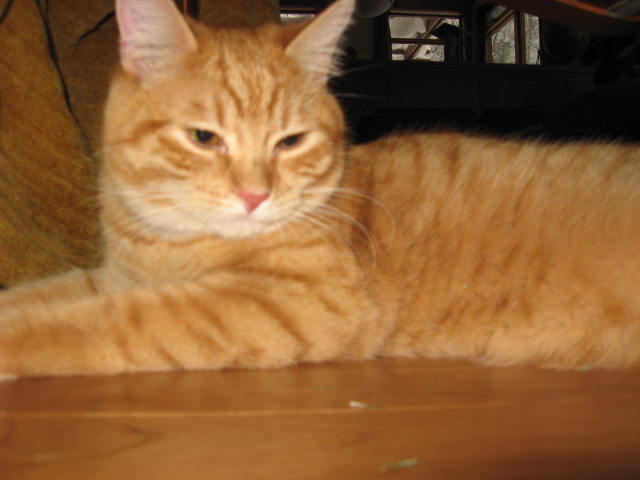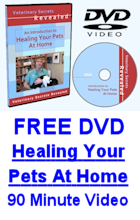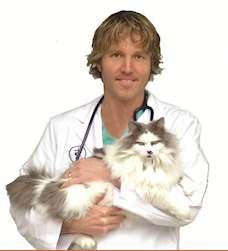|
Hi Friend,

Welcome to Monday!
Today's article is a more serious one, and means you being more intricately involved with your pet's care.
You need to start somewhere, and then practice.
I suggest that you start with my NEW video on HOW to Start With Natural At Home Pet Health Care, then WATCH my video on The Quick and EASY Pet Health Exam:
http://www.theonlinevet.com/innercircle.php
-----------------------------------
Hospice Care
-----------------------------------
Hospice care is beyond important in people- I had first hand experience of this with my Dad dying with dignity in a hospice.
This has yet to really happen for our pets, but you as a pet owner are the ones which should be most directly involved.
No one wants their pets to die alone, especially at a veterinary clinic where they are not really set up for hospice care.
In determining when it's the right time to end the life of your pet, veterinarians are often asked to assess the various aspects that determine the overall quality of life in terminally ill pets.
This is information was presented by Dr. Alice Villalobos a the 2008 Ontario VMA Conference.
-------------------------------------------
The HHHHHMM Quality of Life Scale
------------------------------------------
Hurt— Score 0-10
No hurt: adequate pain control is first and foremost on the scale. This includes the pet’s ability to breath properly. Most people do not realize that not being able to breath is ranked at the top of the pain scale in human medicine. So attention to the pet’s ability to breathe properly is a top priority. Cases with pulmonary effusion need thoracocentesis on an as needed basis. Pet owners need to be trained to monitor the pet’s respirations and comfort level and to identify labored breathing so they won’t wait too long to provide relief. Some families are willing to provide oxygen therapy at home for their ailing pets. The veterinarian can prescribe oxygen through a medical supply house. Pain control may include oral, transdermal and injectable medications and be given preemptively.
Hunger— Score 0-10
No hunger: if adequate nutrition is not being taken in by the pet willingly or by hand or coaxing or force feeding, then placement of a feeding tube needs to be considered. Cats do very well with esophageal feeding tubes. Malnutrition develops quickly in sick animals when the caretaker is not educated enough to know how much their pet needs to eat to maintain body weight. Instruct owners to use a blender or liquid diets to help their best friend maintain proper nutritional and caloric intake. Many pets will live much longer if offered wholesome, flavorful foods that are varied. My own Great Pyrenees, Alaska, went from a life of consuming only dry food to canned food to hamburger, fresh baked turkey, to chicken, to various types of sausages, to venison (thanks to Dr. Jack Stephens), pastrami, cheeses of all types and gourmet cut and marinated meats. She liked parmesan cheese, smoke flavor, Alfredo sauce and cheddar cheese soup mixed into her food along with lots of encouragement and coaxing and hand feeding. It takes patience and gentle concentrated coaxing to get some Pawspice pets to eat. It is hard not to be disappointed when such specially prepared food is rejected. Just come back with another offering with a different flavor a little later and that meal may be more appealing to the patient.
Hydration---Score 0-10
No hydration problems. Educate the pet owner about adequate fluid intake per pound (10 ml per pound per day) and to assess for hydration by the pinch method. Subcutaneous (SQ) fluids are a wonderful way to supplement the fluid intake of ailing pets. It may take a few demonstration sessions for a pet owner to learn how to administer SQ fluids. This helpful procedure saves the client a lot of money and keeps the pet on a much healthier status. Giving SQ fluids can make a huge difference in quality of life during pawspice.
Hygiene—Score 0-10
Good Hygiene is a must! Can the pet be kept brushed and cleaned? Is the coat matted? Is the pet situated properly so that it won’t have to lie in its own soil after eliminations? Pets, especially cats with oral cancer can’t keep themselves clean, so they get demoralized quickly. The odor associated with necrotic, oral tumors can be offensive and cause social rejection by family members. Instruct the pet owner to use antibiotics to help reduce foul smelling infections. Dampen a sponge with a much-diluted solution of lemon juice and hydrogen peroxide and gently stroke the face, paws and legs of the patient. This action is similar to a “mother tongue” and helps to clean the fur while soothing the unkempt cat. Dogs love this type of facial and paw grooming too!
Happiness--- Score 0-10
Happiness is important for both caregiver and receiver. Ask yourself if the patient has desires wants and needs (Comstock 2001). Are these being met? Is the pet able to experience any joy or mental stimulation? It is easy to see that our pets communicate with their eyes. They know what is going on via their senses and mental telepathy. Is the ailing pet willing to interact with the family and be responsive to things going on around him? Is the aging cat able to purr and enjoy being on the bed or in one’s lap? Is there a response to a bit of catnip? Can the cat bat at toys or look and follow a laser light? Can the ailing pet enjoy the upbeat greetings and petting of loving family members? Can the pet’s bed be moved close to the family’s activities and not left in an isolated or neglected area? Is the pet depressed, lonely, anxious, bored or afraid? Do you have a routine fun time that the pet looks forward to? Mobility--- Score 0-10.
Mobility is relative. Ask, is the pet able to get up and move around enough to satisfy normal desires? Does the pet feel like going out for a walk? Is the pet showing CNS signs, seizures or stumbling? Can the pet be taken outdoors or helped into the litter box to eliminate with assistance? Will a harness, a sling, or cart help? Is medication helping?
More Good Days Than Bad Days--- Score 0-10
Ask if there are more good days than bad days. When there are too many bad days in a row, (or if the pet seems to be “turned off” to life), the quality of life is too compromised. Bad days are those filled with undesirable experiences such as: vomiting, nausea, diarrhea, frustration, falling down, seizures, etc. Bad days could be from a condition that worsens such as: cancer cachexia or the profound weakness from anemia, or from the discomfort caused by gradual tumor pressure or obstruction or a large, inoperable tumor in the abdomen This was the situation with my own dear 111⁄2 year -old Australian Shepard, Alfie. He had a huge, undifferentiated mass that rapidly expanded his liver. If the two-way exchange needed to communicate and maintain a healthy human-animal bond is just not there, the pet owner must reconcile or be gently told that the end may be near.
It is very difficult for families to make the final decision to end a beloved pet’s life by euthanasia. Coming to a decision about ending a pet’s life is especially avoided when euthanasia is against the pet owner’s gut feelings or if it against their religious beliefs. Sometimes they are not sure about the quality of life issues at the very end. It can be made more clear to them if a standard scale for Quality of Life is explained and measured ahead of time and re-evaluated every couple of weeks or every few days or hours as the situation requires. If the pet is slowly passing on with a peaceful tranquility, then that may be a satisfactory situation.
What many pet caregivers really want is for their pet to pass on naturally at home, in their arms or in their own bed. That is okay as long as the pet is just weakening steadily and not ‘suffering to death’. We as veterinarians need to accept the fact that it is a very personal and natural wish when our clients request us to help their pet to die naturally at home. We are the ones they turn to for help and we have an oath “to use our scientific knowledge and skills for the benefit of society through the protection of animal health and the relief of animal suffering.” We can help our client’s pet loss needs and at the same time guarantee that the pet has a pain free passage by using the most powerful preemptive pain medications during the last days and hours.
.
Heal Your Pet At Home!
Best Wishes,
Dr Andrew Jones, DVM
P.S. I do wish I had used this more formally in veterinary practice- feel free to let your veterinarian know about the Quality of Life Scale.
You can direct them to this website: http://www.pawspice.com/
P.P.S. My Healing Your Pet Naturally At Home Video, and Quick and Easy At Home Pet Health Exam:
http://www.theonlinevet.com/innercircle.php

DISCLAIMER: This information is for educational purposes only and is not intended to replace the advice of your own veterinarian. Dr Andrew Jones resigned from the College of Veterinarians of B.C. effective December 1 2010, meaning he cannot answer specific questions about your pet's medical issues or make specific medical recommendations for your pet.
PRIVACY POLICY: We will never rent, sell, loan, provide, barter, exchange or in any way make available your personal information to others. You can unsubscribe or change your email address at any time using the links at the bottom of this email.
Copyright 2012 Four Paws Online Ltd.
Tel: 1-800-396-1534
Fax: 1-888-398-1378
www.theonlinevet.com
support@fourpawsonlineltd.com
|